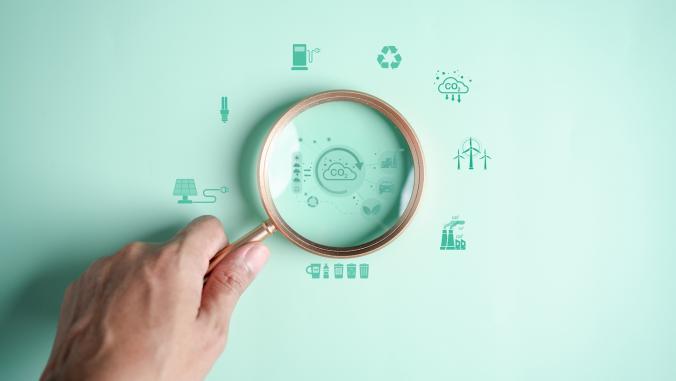What a toothbrush says about the state of the circular economy
Environmentalists and green businesses face a daunting challenge if they are ever to establish circular economy thinking in the corporate mainstream.

A couple of weekends ago, I went to a friend's stag do. The trip got off to an inauspicious start when I got into work on Friday morning to be greeted by an email from my wife telling me I had forgotten my toothbrush. Now, stag weekends are not renowned for their strict adherence to the rules of personal hygiene, but there are limits. So before heading to the station, I popped into a supermarket to see if I could buy a toothbrush.
And there it was. Alongside all the standard, common or garden-variety toothbrushes was the cheapest electric toothbrush you will find, and from a recognized leader in dental care, too. Its recommended retail price was $13.38, but the supermarket in question had cut the price in half, to $6.69.
So for just a little more than a standard, Luddite, non-vibrating toothbrush I could get an all-singing, all-dancing electric toothbrush. The future was within my grasp, and all for the price of the coffee and croissant that necessitated the toothbrush in the first place. Recalling the words of my dentist — "Do you use an electric toothbrush? If not, you should get one" — I bought it.
It was only after I went home a few days later that I realized this humble toothbrush was possibly one of the worst products I have ever purchased; a fact I shared this week with the audience at the Resource Event in London as various speakers discussed the opportunities and challenges presented by the circular economy.
Built to last only a little while
Not only is the toothbrush woefully underpowered, the brush head — which two weeks in is already showing signs of wear — is welded firmly to the handle, meaning that in a few short months the whole thing needs throwing away and replacing. I can't just throw it out because it includes a battery — which is supposedly replaceable but in reality is extremely difficult to get at — and a motor, both of which have their own special waste electronic and electrical equipment (WEEE) recycling requirements.
I've looked it up, and electric toothbrushes are covered by the EU's WEEE directive, meaning I have bought a toothbrush that comes with its very own legislative burden. However, I remain doubtful that the checkout assistant at the supermarket would welcome me returning it for recycling under the directive's “polluter pays” principle.
Of course, not all electric toothbrushes are so woefully designed. You can get electric toothbrushes that you charge using a special holder and replace the heads when they wear out. But these cost at least 10 times more than the $6.69 I paid for my disposable environmental abomination. The idea that a simple clip mechanism, which would allow me to replace the toothbrush head when required, explains the difference in price between a $6.69 toothbrush and a $47 toothbrush is, of course, absurd.
The reality is the company behind the cheap toothbrush wants it to be disposable. It wants me to replace it in six months and the last thing it wants is for me to be able to buy a replacement for just part of it. The motor, the head, the battery, every part of it has been designed to be thrown out and replaced in pretty short order. If that were not the case, I'd be able to easily replace the brush when it wears out and keep using the handle, which looks like it will last for eons once it reaches its likely landfill resting place.
Fight resource profligacy
I told this story at this week's Resource Event in London to illustrate a point: this kind of resource-profligate design is everywhere. There are countless examples of this environmentally wasteful design, from the scourge of single-use plastic bags to mobile phones that don’t let you replace the battery.
Encouraging progress is being made in circular economy thinking, as evidenced by some projects pioneered by our leading retailers. But each and every day these same retailers are selling products that are horrendously inefficient — and we're buying them without a second thought.
There is huge potential for circular economy and resource-efficient business models. From the dematerialization of digital products to the emergence of sharing economy services and advances in recycling technology and material science, we can dramatically boost resource efficiency while growing the bottom line and cutting greenhouse gas emissions. Many companies are already doing just that.
But let's not kid ourselves, the challenge is akin to scaling a Himalayan mountain of toxic junk. Meanwhile, governments won't even tweak the tax system to reward re-use or ban the utterly wasteful practice of sending food and wood and plastic to landfill. Most businesses still seem to reckon the "circular economy" is a business park off the North Circular Road.
If climate change requires us to decarbonize our infrastructure, the circular economy requires that and more. It demands a complete re-engineering of global material flows, business models and psychological consumer impulses. There is not much evidence of this happening any time soon on the scale that is required.
As a general rule I'm hugely optimistic about the prospects for the green economy and the manner in which it can improve all our lives, health and economic competitiveness, while tackling the worst environmental threats we face.
Some great work is underway to enhance resource efficiency in retail, construction, textiles and numerous other sectors. But when it comes to the circular economy, we've barely started on the journey that urgently needs to be undertaken. And if you doubt that, just look at the toothbrushes on offer in your local supermarket.
This article first appeared at BusinessGreen.





